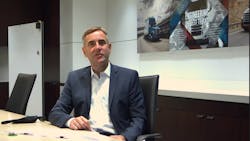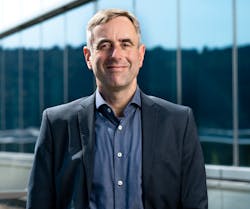DTNA names new senior vice president of engineering, technology
Rainer Müller-Finkeldei joined Daimler’s research labs in 1995 while working on his doctorate degree. Müller-Finkeldei, who has a background in computer science, began working on artificial intelligence (AI) for vehicle powertrains at a time when no one really knew what AI was.
Twenty-five years later, Daimler Trucks North America (DTNA) announced Müller-Finkeldei’s appointment to the role of senior vice president of engineering and technology. Müller-Finkeldei has also been appointed to DTNA’s operating committee as part of the move, the company announced on Aug. 4.
Müller-Finkeldei replaces Wilfried Achenbach who will retire after a 10-year tenure leading the function. In his new role, Müller-Finkeldei will assume responsibility for all DTNA product engineering activities, including design, testing, styling, analysis, compliance, and planning functions. He joins DTNA from Mercedes-Benz Trucks where he has served as director of Mechatronics since 2010.
Mechatronics combines several types of engineering—electrical, computer, and mechanical—and refers to the skill sets needed in the contemporary, advanced automated manufacturing industry.
“Over the last 10 years, the mechatronics portion in our trucks have become a pretty dominant factor,” explained Müller-Finkeldei during an Aug. 4 roundtable discussion with trucking industry media.
“One of my greatest pleasures was having the chance to roll out and get our mechatronics systems in all the brands worldwide,” he added. “This is what I am most proud of after working in that for 10 years, we all share those innovative, leading-edge technology systems in all our truck brands of Daimler Trucks worldwide.”
From 2006 to 2010, Müller-Finkeldei served as the senior manager of Mechatronics’ integration and validation team. Since joining Daimler, he has held increasing roles of responsibility across Daimler business units and engineering functions, including Daimler Trucks product creation group, electronics development at Daimler vans, and Daimler’s research and technology department.Müller-Finkeldei obtained his doctorate and master’s degrees in computer science and physics from the Julius-Maximilians University of Würzburg, Germany, and he studied computer science at both the University of Würzburg and the University of Texas at Austin. Müller-Finkeldei and his family will relocate to Portland, Ore.—DTNA's North American headquarters—from their home in Stuttgart, Germany.
“Taking over the lead for full vehicle development is a great opportunity and something I have been working toward for 20 years,” Müller-Finkeldei said. “It’s exactly the right step to move forward—joining the executive team here and being part of the team that structures the whole business of this great company.”
Future of trucking
Moving forward in his role Müller-Finkeldei expressed his excitement for DTNA to lead the charge for the future of trucking, which includes pioneering autonomous truck technology.
“I am really happy to be involved in our journey to pioneer autonomous trucks,” he said. “It was something I was fascinated about right from the beginning. For me, it is one of the technologies that has the potential of changing the overall trajectory of the transportation industry globally. Yes, there are still many things to conquer, explore, learn and innovate, but it’s a pretty great vision.”
Müller-Finkeldei also noted that he has been part of the electric-drive and autonomous development of Daimler from the beginning.
“When our board of management three years ago asked the question, ‘Is there anything in autonomous trucking,’ I was in that first group that started talking about moving forward and doing that,” he pointed out. “Now, being part of the implementation is something I am really looking forward to.”
Müller-Finkeldei explained that when it comes to autonomous trucking, Daimler is focused on making Level 4 autonomous driving possible. As for full, Level 5 automation, Müller-Finkeldei said that will not happen in this decade.
“We are convinced that the way our customers use our trucks in their business, there is one portion that has a good chance of being a good segment where Level 4 autonomous driving is technically possible and makes sense. That is the classic hub-to-hub delivery on routes where we have exact mapping of the roads, where we know exactly what’s going on, and where we can closely monitor those vehicles,” Müller-Finkeldei explained.
During the media call, Müller-Finkeldei was asked about battery-electric vehicles and the biggest hurdles for full fleet adoption. Müller-Finkeldei pointed to Daimler’s Truck and Bus segment, where he said the company first put electric commercial vehicles to use.
From there, Daimler took its knowledge from the bus segment and transferred it to commercial trucks, putting a limited number of trucks into operation to start.
“It’s not enough to simply have an electric-driven truck with some batteries and an electric motor, you have to have the full environment and infrastructure in place for your customer,” Müller-Finkeldei advised. “You have to work with your customer right from the beginning to figure out if their application is suitable for an electric drive.”
He noted that other potential challenges to consider are charging stations and how much power is needed to charge certain applications.
“What we have for those vehicles is still limited volume and pretty high-priced components,” Müller-Finkeldei said. “If you look at today’s situation, the cost of the technology is still too high to compete on an economical basis with conventional vehicles with diesel engines.”
“Over the course of this decade, we will see electric vehicles coming to a point where for certain applications—those with a limited range of 100 to 200 miles or a little more—that this will come into a position where it makes sense from an economic standpoint to move over from conventional combustion engines to electric,” he added. “Besides that, you have to keep in mind that when you look at society in total, there will be areas and applications where, from a legal point of view and a regulatory point of view, combustion engines might not be around anymore.”
Müller-Finkeldei emphasized that Daimler will continue to focus on delivering fuel economy benefits for traditional diesel engine vehicles.
When asked about globalization and how his insights from working in Europe would crossover in the North American market, Müller-Finkeldei explained that as a whole Daimler started that path of looking at where it makes sense to share globally between all the different markets many years ago.
“We went through all the different phases and learned in the beginning that just carrying over and not caring about specific market needs is not the right thing to do,” he explained. “Then, moving forward, we tried to identify those systems where we consider all the requirements that come out of different markets right from the beginning. We focused predominantly on mechatronics systems, and we are now on our way to make that even broader. We also looked at the more classic systems. One of the classic systems that we’ve had great success in is the powertrain. We have a global powertrain family, which is where we were able to achieve global market share.”
Moving forward, DTNA teased its next Western Star product launch for the vocational market.
“What’s really exciting is taking the next Western Star in its natural habitat in off-road conditions and figuring out how all the stuff works and what is very specific about this vocational segment,” explained Müller-Finkeldei. “I am convinced that the team that was led at the time by Wilfried Achenbach did a great job developing a great product, which I am convinced will be the next big thing in the vocational market.”
About the Author

Cristina Commendatore
Cristina Commendatore is a past FleetOwner editor-in-chief. She wrote for the publication from 2015 to 2023.

